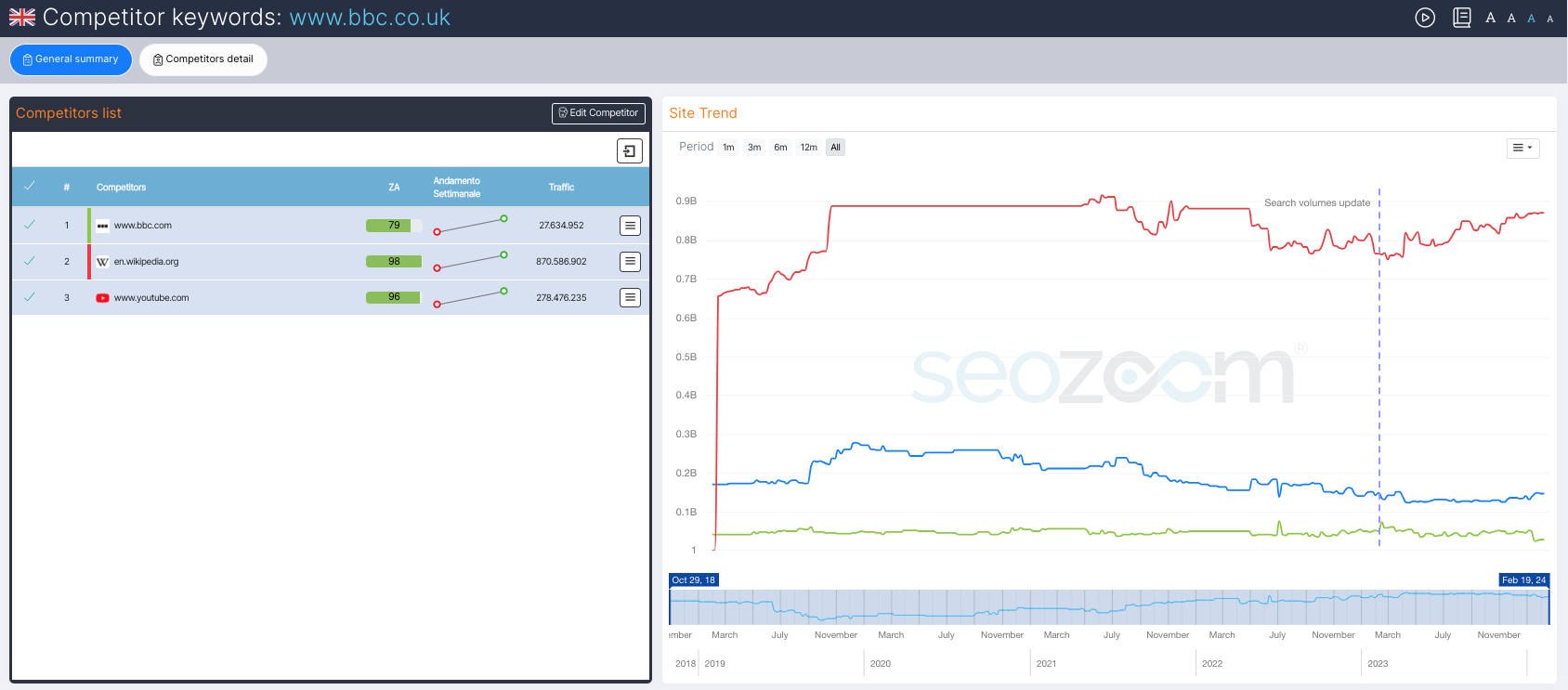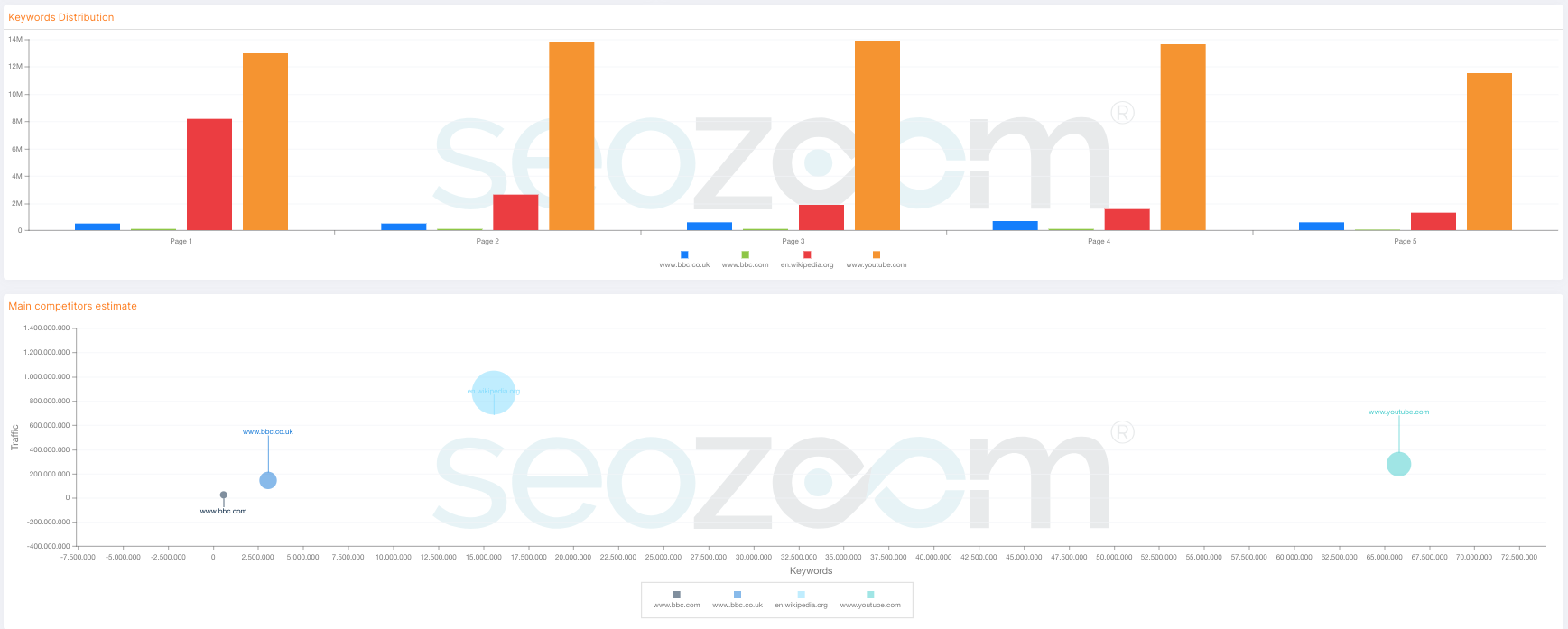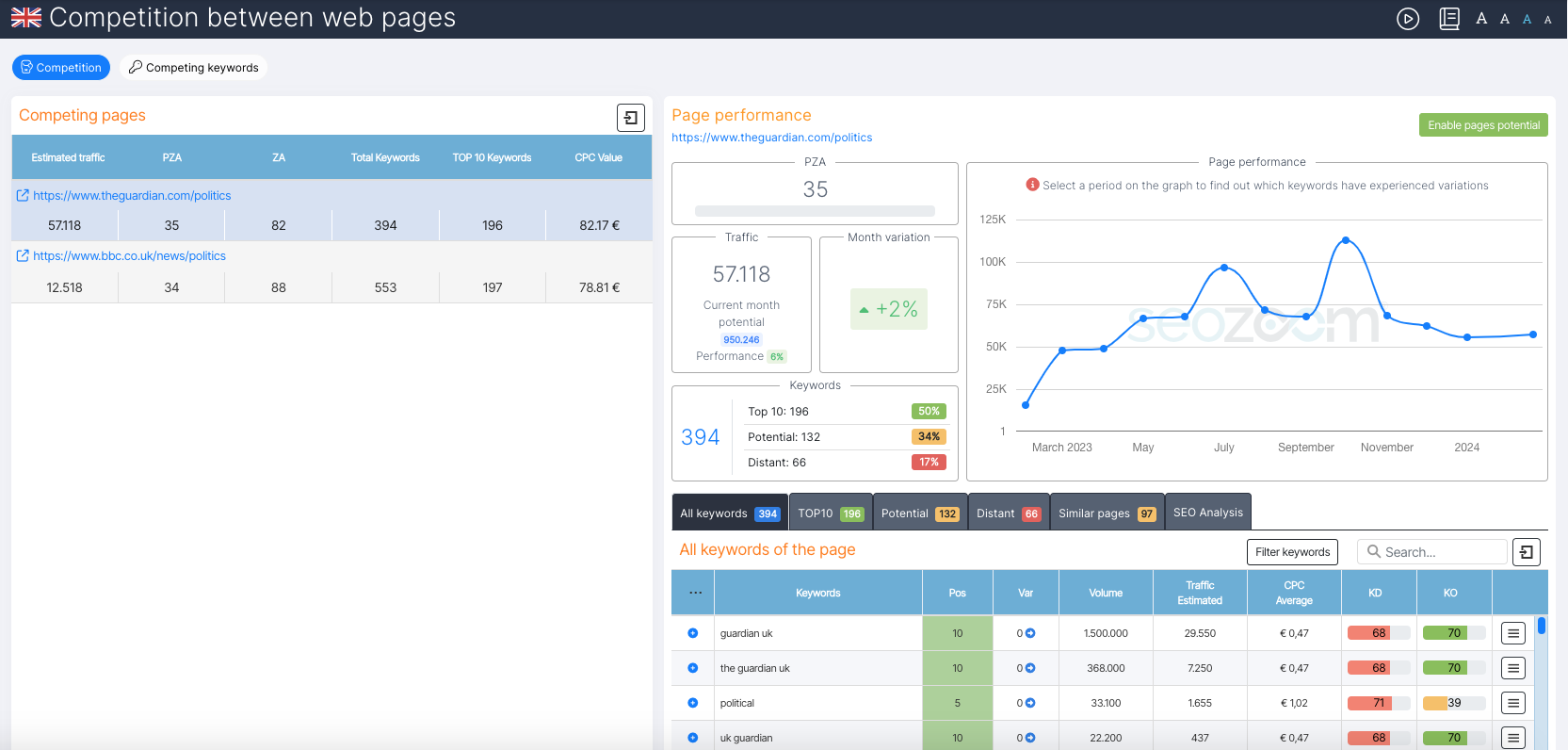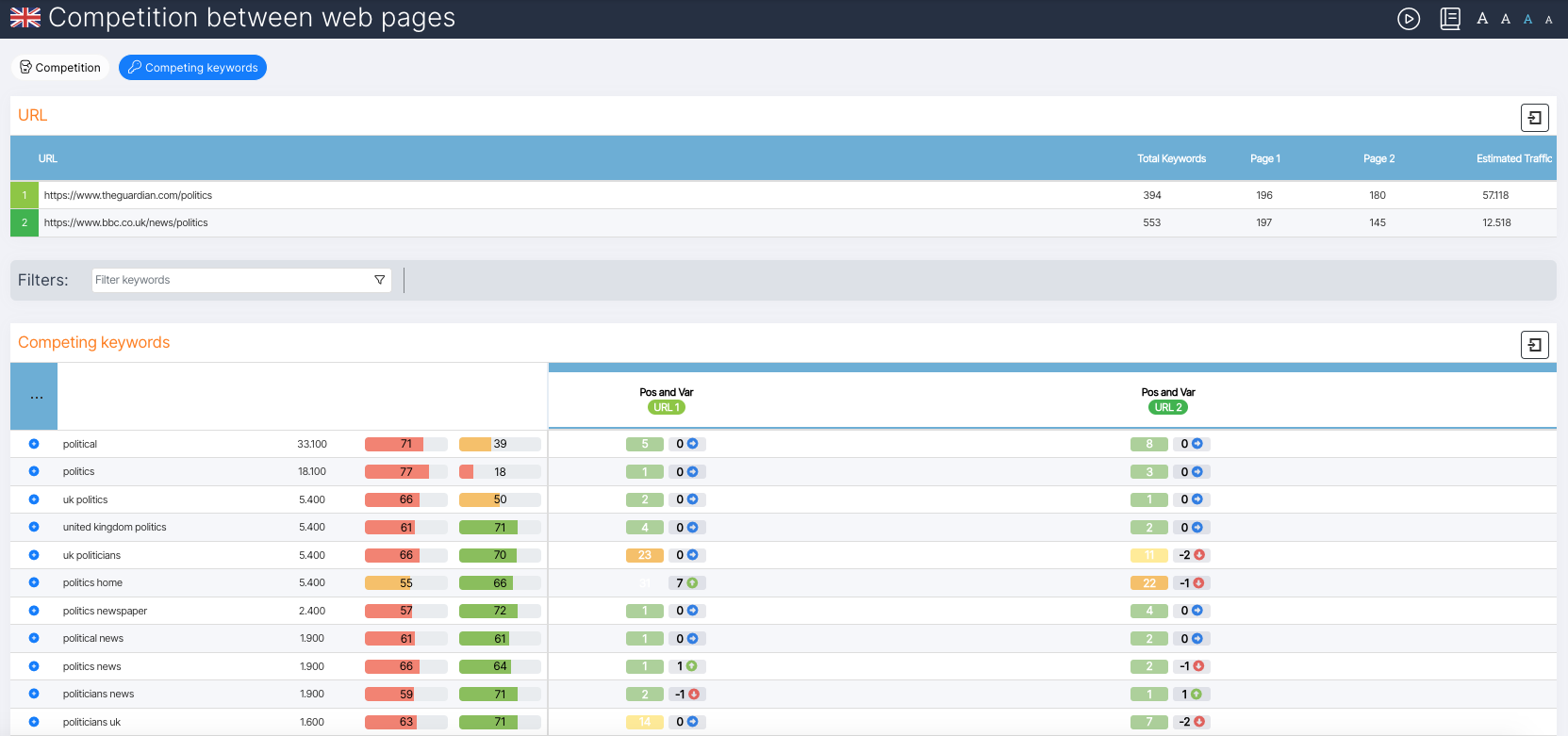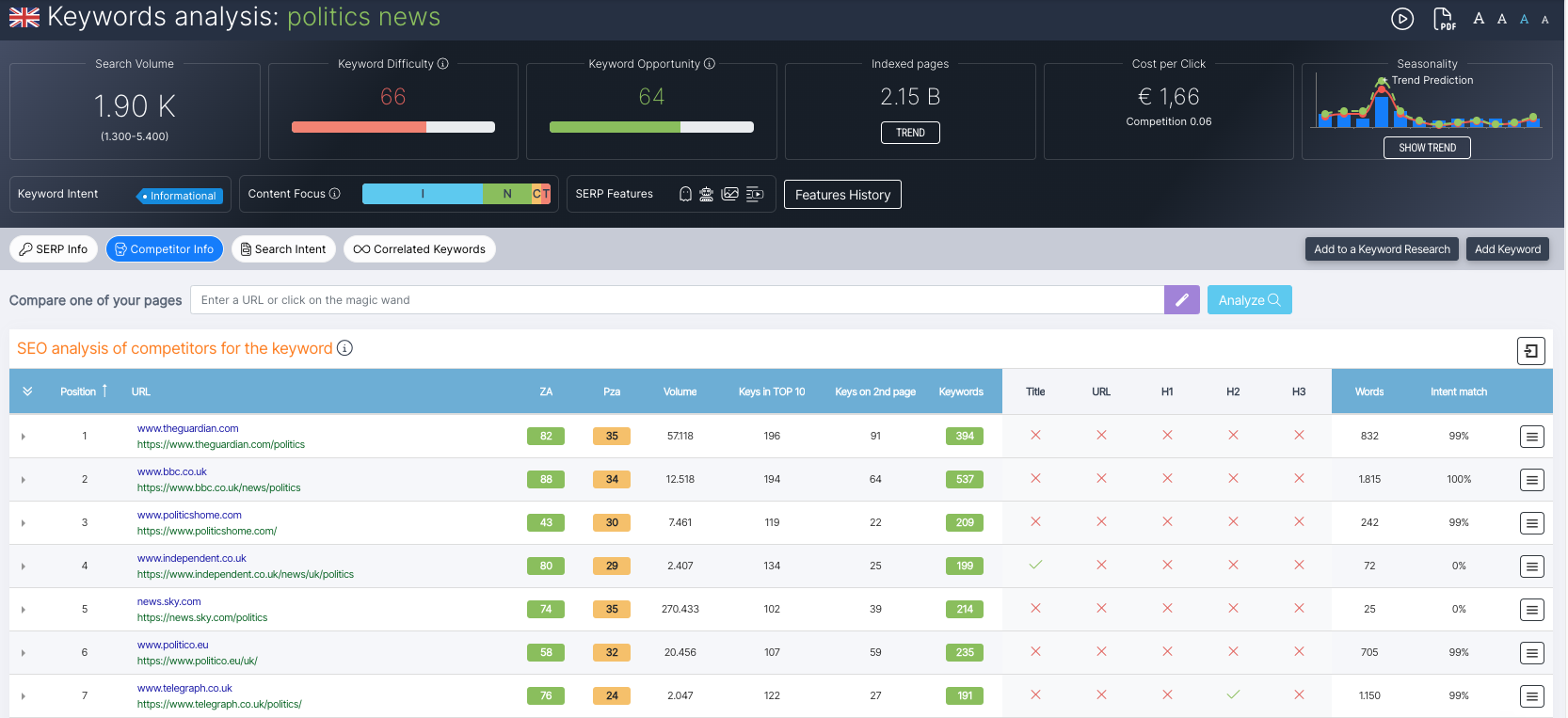Competitor analysis and SEO: spying on competitors to outperform them
The latest statistics say that, by 2024, there will be nearly two billion sites across the Web, that total Internet traffic has exceeded 4 zettabytes, and that, most importantly, worlwide users are now more than 5.3 billion, meaning that two out of every three people in the world are currently connected to the Net. In short, the Internet is increasingly populated and, therefore, thinking about an online project without having a clear picture of the whole context, starting with the competitors already present, risks being a short-sighted and ineffective choice. Today more than ever, therefore, keeping an eye on the competition, carrying out a competitor analysis and studying the moves of rivals is one of the first activities to be done when trying to carry out a marketing strategy, in the physical world as much as (and especially) in SEO and on the Web. So let’s try to understand who exactly these “competitors” are in the online universe and how we can identify and analyze them effectively, thanks in part to SEOZoom.
Who are the competitors: not all websites represent competition
Online competitors are not all the sites on the Web, and this should be easy enough to guess. The opponents that deserve our analytical and strategic attention, our real competitors, are the sites that share a market segment with us, that offer similar products or services to ours, that target the same audience as us, and that fight for visibility in the same niches or for the same keywords.
Conquer your competitors’ traffic
The relevance of an online competitor is then determined not only by its size or its volume of traffic, but also by its ability to influence the decisions of our target audience: in this sense, a small niche blog can be as much a competitor as a large e-commerce, if both compete for the attention of our same segment of users.
More analytically, we can divide competitors into three categories, each with its own peculiarities:
- Direct. These are the companies that offer products or services that are identical or very similar to ours and appeal to the same target customers. Their presence in SERPs for keywords specific to our industry is a direct indicator of competition.
- Indirect. These competitors offer products or services that are not exactly the same as ours, but meet the same need or solve the same problem for the customer. They may not compete for the same keywords, but they fight for the same market share.
- Perceived. These are those brands or websites that our target audience might consider alternatives to ours, even if they do not directly offer the same type of product or service. Their influence extends through branding and consumer perception.
Competitor analysis, studying means being competitive
But what is the point of identifying competitors and knowing the moves of opponents?
The answer comes from the theories of microeconomics, which call competitor analysis or benchmarking “a fundamental part of a company’s marketing plan,” because it allows one not only to discover others’ strategies from which to possibly draw inspiration, but also (and more importantly) to ascertain what features make the product or service provided unique and what attributes are decisive in attracting the target audience, providing a snapshot of the current state of one’s market of interest.
In general, competitor analysis is the process of systematically researching and evaluating the strategies and performance of our market rivals; through this work we can gather valuable data on how competitors position themselves in the market, what keywords they use to attract traffic, what kind of content they produce, and how they interact with their audience. This information is critical to identifying opportunities for differentiation and understanding what strategies are working in our industry.
Also part of this complex activity is SWOT analysis and, going further, the predictive study of possible market scenarios with what-if analysis, using typical game theory models in which the dimensions analyzed become case study variables.
And benchmarking more properly speaking also goes hand in hand: it involves measuring our performance against that of our direct competitors, establishing benchmarks, or “benchmarks,” to assess our position in the market. Through benchmarking, we can identify industry best practices and adopt or adapt them to our strategy; we can also set realistic and measurable goals for continuous improvement of our marketing and SEO activities.
Competitor analysis in marketing
In addition, competitor analysis also represents a signal of awareness of one’s own “status,” that is, consideration of the presence of others in the marketplace, from which arises the need to take actions that also take into account opponents, precisely.
Specifically in online marketing, competitor analysis also serves to perform an assessment of the strengths and weaknesses of current and potential competitors, ensuring strategic information both offensively and defensively in terms of ranking for certain keywords, estimated traffic, investment in terms of Ads, performance in the SERP. And SEOZoom (spoiler alert!) allows you to “spy” on these opponents with refined precision, offering especially those working in very competitive industries to have all the tools to fight position by position.
How to spot organic competitors online
To enter into strategic optics, therefore, the first action to take is to identify one’s competitors, that is, to try to find out which sites are precisely competing and active in the same “branch” as ours, that is, they sell services or products with reference to the same target customers.
Although it is often repeated that competitor analysis is a key element in fine-tuning an effective online strategy, it is not always easy to recognize who your project’s competitors really are, both because of the difficulty of defining the “field” in the general Web landscape and the complexity of finding the necessary information. For example, you may happen to know “by reputation” some direct competitors in your field of activity or consider only local business “dangerous,” only to find out later that the real online rivals are quite others, eroding market share in terms of keyword placement and traffic.
SEO Competitors, why study the moves of rivals
Already from these few lines, it is clear why carrying out an SEO-oriented competitive analysis can be important for achieving one’s goals: first, it allows one to understand what content is rewarded by search engines pertaining to our industry, and then also to find out what tactics are working and what activities are getting better results. The insights that come from such a study should then be applied to one’s own project, in order to overcome the present limitations and, as an ultimate goal, outperform these same competitors.
To put it in marketing terms, competitor analysis and the study of online competitors represent both a “threat” and an opportunity for our business: while it is obvious that the presence of other players on the scene can have consequences that impact our site, both in terms of traffic and keyword rankings, it is perhaps less intuitive to interpret “opponents” in a positive key, as levers to be exploited to optimize the site.
Not being afraid of competitors is also one of the suggestions that came from John Mueller during one of his periodic hangouts: in particular, Google’s Search Advocate explained that the search engine system can successfully differentiate similar domains, even if they possess similar link profiles. This means that even in cases of “unfair” and fierce competition (with sites brazenly copying domain names or imitating editorial strategies or link building campaigns from their own design) Google is still able to identify the “original” one, so to speak, which is rewarded with higher preferences in search results.
This is very useful information for webmasters and site managers concerned about competition, which can alleviate some of their worries and, at the same time, also offers another practical tip for fine-tuning a winning strategy: one should never slavishly and flatly copy competitors’ activity, but should use the tools available to understand what competitors’ strengths are and, consequently, what weaknesses and aspects to improve in one’s own project.
Online competitor analysis, three aspects to compare for better results
Technology, content and backlinks: wanting to summarize as much as possible, these are the main aspects on which to focus our attention in performing a quick online competitor analysis, to try to compare our project with those of better positioned or more emerging opponents who are gaining Google’s approval. Indeed, it is always complex to follow the evolution of Google’s algorithms, so the old tactic of “spying on opponents” can still give the right cues to gain positions and visibility in SERPs.
Also reiterating the current importance of competitor analysis is Chuck Price on Search Engine Journal, who offers his 3 methods for quickly performing this check to find areas where we can improve our site’s optimization. According to the expert, the challenges and obstacles to reaching the top of the SERPs and staying there have become greater and greater, and “the introduction of Knowledge Graph, Hummingbird, RankBrain and BERT into Google’s algorithm has made it much more difficult for SEO professionals to game the system.”
Although Google’s webmaster guidelines have not changed much over the years, in fact, the same cannot be said for the core alghoritm, which indeed has “an evolution that happens at a very fast pace” and is “too complex for reverse engineering.”
Therefore, it is useful to find common patterns by “digging into competitive research,” performing careful analysis of organic competitors that can give us “an idea of what the algorithm is looking for when determining what results to return for a particular query.” There are three elements into which, at the most basic level, a site can be divided-as we said, technology, content and backlinks-and these are the tips for comparing our site with those of competitors.
Analyzing competitor websites: the weight of technology
Every webmaster’s goal is to produce a well-structured site that is fast, easy to use and easy for crawlers to crawl.
Achieving these results doesn’t require specific technologies, but “if you’re starting with a new site or considering a redesign, it’s definitely worth taking a look at the competition,” suggests Price, who also points to a specific resource for obtaining this information, namely BuiltWith, a tool “that SEOs can use for competitive research.”
Analysis on this tool provides data on a range of installed technology profiles, including information on:
- Analytics and tracking systems.
- Widgets.
- e-Commerce.
- Frameworks.
- CDNS.
- Mapping.
- Mobile.
- Payment systems.
- A/V Media.
- CMS.
- JS libraries and functions.
- Advertising systems.
- Verified links.
- SSL certificates.
- Web hosting providers.
- Server names.
- Email hosting providers.
- Web servers.
- Operating systems and servers.
- Syndication techniques.
- Webmaster registration.
Studying the website architecture of online competitors
Understanding the way competitors’ site structure is organized can be useful in terms of defining page hierarchy and uncovering potential gaps in product or content.
Again, the author suggests a tool for mapping the competitors’ site-specifically, Xenu Link Sleuth, a free tool that “has stood the test of time.”
Check Core Web Vitals
We know that Google is moving beyond simple page speed as a ranking factor and that Core Web Vitals are now part of a more complex signal used for rankings (the weight of which, however, is still rather limited).
Using Google’s words, however, Core Web Vitals provide “unified guidance on the quality signals that are essential for all sites to deliver a great user experience on the Web.”
Analyzing our site’s performance and comparing it to our opponents’ allows us to find out how well we are optimized for Google’s chosen parameters-and how far we still have to go to reach our quality goals.
Competitor SEO analysis: focus on content
Perhaps more immediate is the second area of competitor site investigation, namely the content and keywords that work for our opponents: in rather practical and opportunistic terms, thanks to tools (such as SEOZoom!) it is possible to leverage the work already done by our competitors to drive organic traffic to our site.
What we need is precisely a tool that can give us an overview of our competitors’ organic keywords – of course, we refer to SEOZoom‘s various features – through which we can easily determine which queries are directing traffic and their ranking potential and, most importantly, how their content is organized (on which pages and with which search intent).
Equally important is to find out if there are opportunities we are missing, i.e., keywords we could be working on but have never thought of content for, by performing what is called content gap analysis, an ideal way to find keywords highly relevant to our site’s topics and some potential new business opportunities.
Studying on-page optimization
Price acknowledges that “Google may not be as dependent on meta tags since the introduction of Knowledge Graph, but having a clear roadmap for both users and search engines is still important.”
Again, there are various tools to understand the relationship between our site and that of our competitors, and in particular the author mentions SEOBook’s Webpage Similarity Comparison Tool, which generates analysis related to page title, meta tag description, keywords, text and word count, main two- and three-word long tail keywords, and so on. This is all information that, as we will see, we can also find in SEOZoom’s various tools, from the “domain vs. domain” function to the URL comparison function, to the Competitor tab that allows us to perform a comprehensive SEO analysis of the pages of the best-ranked competitors.
When using these tools, Price suggests, we need to remember to “look for patterns,” that is, to figure out what wording pattern Google is liking (and we are not using), so that we can reorient our optimization work in light of this information: this, of course, does not mean simply copying, but taking cues in creative and original ways to go along with trends.
Check your competitor’s backlinks
Of course, long gone are the days when “SEO professionals chased down every backlink from a competitor in order to neutralize the advantage the link could provide”: everything changed after the introduction of the Penguin update in April 2012, which twisted Google’s approach to links from a spam-fighting perspective, effectively making the value of some “junk” links suddenly negative, which went on to dangerously soil a site’s backlink profile.
Despite this, however, Price argues that “competitive backlink mining is not a bad idea,” if we know how to use our heads and understand which potential links are “worth the effort it takes to acquire them.”
Wanting to offer more precise advice, finding out which sites link to pages of our competitors gives us two types of indication: on the one hand, it highlights which pages are the most valuable on our opponents’ sites (those that are linked to naturally or are the focus of link building campaigns because of their conversion potential) and thus lets us know which keywords to focus on. On the other hand, it also allows us to find new sites that host links, with which to get in touch to promote our work, especially in case of vertical topics in topic with the content of our site.
SEO competition analysis, the basis for optimizing the site
The ones just described are 3 quick ways to spy on competitors and derive useful insights to improve our site.
As Chuck Price clarifies, “content and links will continue to be the backbone of Google’s algorithm for some time to come,” while the definition of the best structure may evolve based on user demands and needs.
What is important is to understand who we are facing as adversaries and to “neutralize any competitive advantage,” two important aspects in developing an effective marketing campaign, which must be – of course! – followed by the development of unique and useful content, which is the lever with which to try to “rule the SERPs.”
How to do a competitor analysis with SEOZoom: all the tools and techniques
We now know that competitor analysis is also used to understand the paths that competitors in a given industry are taking, so as to identify their strengths and weaknesses and set up more effective strategies.
But how to find competitors online? Support comes to us, as already suggested, from several tools within SEOZoom, which allow us to get a virtually complete picture of the market on which our site operates – even in small niches or emerging sectors – and to discover all useful data about our opponents.
In particular, already at the domain analysis stage the suite’s algorithm immediately recognizes the most likely organic competitors, providing a list of “accurate” and “appropriate” sites to compare against for competitor analysis.
Competitor analysis with SEOZoom to find a site’s organic competitors
From a technical point of view, the algorithm that identifies a domain’s competitors performs a processing of the various sites every 15 days, which basically allows it to update, verify and intercept new competitors on a biweekly basis. Moreover, compared to other SEO tools, which rely on simple content and keyword relevancy to determine the level of competition (and, in practice, end up comparing very large domains, such as Wikipedia or YouTube, with much smaller sites for which they were out-of-reach rivals), SEOZoom considers competitors “domains that compete on a large number of keywords in common with their own website and yet have a search volume that approaches that of the website itself.”
As an evaluation criterion, therefore, we have decided to pay attention to the value of traffic, and to be precise, direct “downward” rivals are those that generate at least one-third as much traffic as one’s own site while, on the contrary, for competitors that are in front, domains that have 15 times their own organic traffic are shown, so as to offer a concrete perspective of what the growth goals might be.
SEO competitor research: zoom authority, rankings and niches
To further refine online competitor research, the suite also allows us to discover a number of potential competitors, i.e., sites that are likely to enter the “niche” in the near future because they are about to emerge thanks to good rankings (while still remaining “under the radar”).
One feature we can use in this regard is “Website Rankings,” which shows the top 100 websites that get the most traffic estimated by Google in so many areas, covering virtually all niches and all sites that have high trust for the search engine.
The metrics that can help analyze the competition at a glance are Zoom Authority and especially the newer Topical Zoom Authority: the ZA is a metric that is now appreciated and recognized in the SEO and digital marketing field, quickly establishing itself as a valid indicator for those who need to evaluate the quality of a website, while the TZA was introduced precisely to allow a more efficient competitive categorization of sites that operate in small market niches.
In summary, the Zoom Authority number value allows an immediate understanding of the health of a website and its performance in Google searches, representing a ranking of the domain in the entire web landscape and indicating Google’s behavior and liking of the website in question. The “revolution” compared to other systems stems from the parameters used to define the ZA, which are the same metrics as Google’s algorithms, such as quantity and quality of keywords placed, stability of ranking, “real” traffic, and opportunities for growth, encapsulated in the three indications of Trust (summarizing the trust shown by Google for the website in question), Stability (the level maintained by the website’s organic ranking), and Opportunity (how much the website can grow in the following months).
Topical Zoom Authority takes this a step further, as it is able to rank each site within a topic, effectively creating a new ranking and allowing us to know the best site for each online industry.
Google also uses metrics to rank domains
Confirmation of the strategic value of a metric like Zoom Authority comes (once again) from the words of John Mueller, who again in 2018 confirmed something many were already speculating, namely that Google also uses internal systems to map and track sites. Specifically, Mueller clarified that Google has both site-level and page-level metrics, which are also used to “map into similar things.”
On the occasion, the Googler had also added that the algorithms also rate new content differently based on the authority of the site that publishes it: if it is an unknown website or a website that Google rates as being of lower quality, it will not be ranked quickly or easily, while conversely a well-known site that Google trusts will get fast and generally better results. This system is based not only on links, however, but on Google’s general idea of a site: if it generally offers good content, perhaps read and appreciated, it is likely that the new content will also be of that level and therefore rewarded with a higher rank value by the algorithm.
Competitive analysis, how to find organic competitors for a project site
As we know, SEOZoom allows maximum control over the health of our site when we place the domain among the monitored projects, and on the subject of competitor analysis, those who have more slots available can also think about profitably placing an opposing domain among the projects, to be monitored in the most analytical way possible! In fact, those who are involved in web marketing know very well that one of the fundamental steps when trying to improve results is competitor analysis, which is used to understand the paths being taken by competitors in a given field to identify their strengths and weaknesses and set the correct strategies.
Competitor analysis with SEOZoom: a quick guide
There are several ways SEOZoom guides us to find direct competitors within the SERPs, that is, the sites that by keyword and topic battle with our project for the most visibility on Google.
Leave no room for other sites
Already in the Project overview of the suite we can access the section dedicated to competitors, where we can find the results of sites automatically identified as organic competitors or added manually, and read here all the useful information, such as traffic volume, number of keywords placed and so on.

How to find organic competitors with SEOZoom and analyze performance
From the table on the left, clicking on a competitor’s domain allows us to add or remove values on traffic performance within the graph, so we can compare our values with those of other sites.
The table also allows us various levels of interaction, to analyze the competitor site in more detail, and gives us access to the content gap visualization, where we can find out what content “holes” are present on our site, and then again the keywords in common, the keywords on which we are winning or losing in direct comparison, and the “Top 10 competition” (keywords for which both domains are ranked on the first page on Google).
Going back to the general visualization of the feature, under “Keyword Distribution” we find a bar graph that allows us to analyze the keyword ranking in the first five pages of Google: on the x-axis are represented the first five pages of the search engine, while on the y-axis we have represented the number of keywords of the various competitors recognized by SEOZoom. By crossing the data, we can see and understand the volume of keywords placed by our site within the SERPs compared to that of the competitors.
Scrolling further down the page we find the table with the Main Competitor Estimate, which is very useful for a quick competitor analysis because it allows us to immediately see what is the position of all the sitins in terms of organic traffic and keywords placed on Google.
Competitor analysis, SEOZoom’s functions for this activity
If, on the other hand, we have not entered our project domain (or if we do not want to compare our site with known direct competitors, but only do a research oriented to study an industry, for example), we can still use other functions of the suite that allow us to obtain useful information about the market niche.
In particular, we can decide to start with the inclusion of two domains (domain vs. domain), at least two URLs (competition between web pages) or the addition of a keyword list (competitors on keyword list, with which to analyze the domains most present on the first page of Google for the list of keywords of interest, showing the difficulty of the keywords and the current rankings of competitors), and now let’s look in detail at some of the possibilities.
Competitor analysis: comparing domains
Let’s start with the Domain vs. Domain tool, which can be accessed by clicking on the “Competition” section in the side menu of the suite: a popup will appear in which we will enter the referring domain and, in the next box, we will go to indicate the site with which to compare it.
In a few seconds, the SEOZoom engine will launch a complete analysis of these two sites (to which we can eventually add others for more extensive monitoring), with graphs showing the overall trend of organic traffic over the last two years, the distribution of keywords in the first 5 pages of the search engine, and the estimate in the ratio of keywords to traffic. As happens to the described function available within the projects, we can deepen the analysis by clicking on “competitor detail,” from which we will access a more specific comparison on the most important keywords that generate the most traffic and search volume.
This feature is useful for comparing domains already on the market, analyzing their performance and, in key work on our site, finding out which areas we have more potential and improve our ranking on potential keywords compared to competitors.
Competitive analysis starting with two URLs
If we want to limit the analysis not to the entire site, but only to a specific page that is strategic for us, we can use SEOZoom’s “URL vs. URL” tool: the immediate popup allows us to directly enter the address inside the search bar, but we can also start from a specific keyword by clicking on the magic wand symbol.
After entering the addresses to be analyzed, the software offers the analysis report with a complete set of information about the pages and their organic performance: estimated traffic, Page Zoom Authority, overall Domain Zoom Authority, total keywords, keywords placed on the first page and average CPC volume, which can also be viewed in the contextual graphs and tables.
The area to focus on in terms of competitive analysis is activated by clicking on the “competing keywords” tab and clicking on the little arrow on the left, which allows us to see and monitor all the keywords for which pages compete, with key benchmark data.
Optimize single keyword with competitor analysis
SEOZoom offers us great support even if we are in the content optimization phase to try to gain better rankings, allowing us to analyze various facets related to defining the right focus to give to the article and the page, also working on the target keyword we have set.
This work also imposes a “philosophical” type of change to redefine search intent, a new mental effort to understand in advance how the search engine results pages are moving to try to intercept the answers that people (and consequently Google) expect to have when they launch a query, thus intervening in the content offered by our site. Search intent analysis remains a fundamental activity for fine-tuning one’s strategy, but no less useful becomes reasoning about how to be more competitive on the target keyword, which of course is followed by all the variants.
Competitor analysis with SEOZoom to work on the single keyword
A first tool to delve into is found among the functions of “analyze keyword,” in the “competitor analysis” tab: by entering any keyword, SEOZoom shows the results of the first page of Google complete with detailed information on how content is structured and the snippets used by the best-positioned opponents, with lots of insights that help us understand what are the key aspects to intercept the liking of users and search engine.
In addition, by entering a URL of our site from here we can launch a more in-depth competitor analysis, performing a direct comparison with the pages that Google has (at the moment) awarded as the best for the identified intent.
The editorial assistant’s suggestions
Those who use SEOZoom for content writing, then, can count on the continuous support of the suite’s editorial assistant, which really accompanies the copy in the process of content creation, and in particular traces a “safe” way to optimize the work on the target keyword.
In fact, by entering the desired keyword, the system generates SEO optimization tips based on classic Google guidelines and best-practices that serve as guidance to the writer, with guidance on title and meta description lengths that sit alongside more purely practical cues such as managing headings, images and keyword sets. In addition, and herein lies the advantage over competitor analysis, the tool also suggests the headings used by competitors in SERPs, so you can understand how your opponents have moved and act accordingly.
The other useful tools for doing a competitor analysis
Continuing to sift through the suite’s functions useful for the activity of gathering data and information on opponents, which can then be processed to use for strategic decision-making purposes, we find other tools that help us discover and monitor the keywords of one’s organic competitors.
For example, “Niche Investigation” is used to check which keywords are the most interesting in the target sector starting from the moves of the website reputed to be the strongest in the niche, obtaining a complete Keyword Research for the sector selected from the thousands of categories identified by SEOZoom.
With the Time Machine, on the other hand, we can delve into the pages and keywords of our domain that have lost traffic during the indicated period and, in this way, find out which sites have obtained better rankings instead.
A support for keeping the site competitive
Ultimately, competitive analysis is a strategic activity because recognizing organic competitors can help you better plan marketing initiatives, identify your own gaps, stay in line with the latest market trends, and decipher your position in the market.
In this sense, SEOZoom proves to be a reliable ally in fine-tuning online strategies for sites of all kinds: just to give a few examples, an eCommerce site will also find information about the competition useful in identifying areas of the site to improve or even new products to add to its catalog that are “making the fortunes” of its opponents, while on the other hand, editorial sites can enhance their content by studying competitors and intercepting their strategies.
On the content side, moreover, competitor analysis first of all simplifies keyword research and allows us to perform accurate studies, including semantic studies, on the content of our main competitors in order to gain insights and be more competitive.
The actions described above are fully part of the economic theory of gap analysis, that is, the analysis of the gap that exists between one’s own project and that of the competitor: SEOZoom’s tools allow precisely to quantify the eventual gap that needs to be bridged in order to improve and make the site more competitive, highlighting the areas, keywords and articles in which the same performance is not achieved.
As Eastern philosophy teaches, it is precisely from the shortcomings that we can start again, studying the actions to be implemented to regain ground and perhaps overtake those ahead of us.






